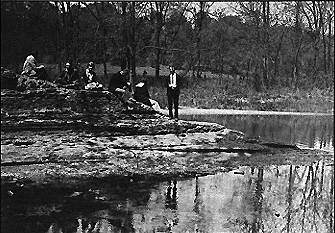

Last week the college and the city of Oberlin announced that together they might eventually reopen Crane Pool. If they agree on an arrangement for sharing that facility, it will be the third time in recent years that the college has made such an arrangement with one of its neighbors. The Lorain County Ice Hockey club leases the college's skating rink while scheduling time for college use (Observer 21 May 1992), and the Lorain County Metropolitan Park District has purchased the Chance Creek area with a guarantee that Oberlin's biology students will continue to have appropriate access to it.
The college built Crane Pool in 1931. Until last summer the city of Oberlin regularly used it for its swim program, which included recreational swimming and lessons for children. In fall 1993 an audit showed that the pool and its building--a wing attached to Hales Gymnasium--needed repairs that would cost an estimated $340,000. Faced with a budget shortfall, the college closed the pool (Observer 28 October 1993).
Now the college is conducting a study to determine the cost of repairs today, and the college and the city have begun what Oberlin city manager Gary Goddard describes as "very preliminary" talks that may lead to the city's sharing repair costs and then leasing the pool and its locker rooms from the college. The city might have year-round use of the pool while allocating time slots to the college. All college swimming programs now use Carr Pool, built in 1971, but because it lacks shallow water it is not suitable for teaching beginning swimmers. There are two pools in the Crane facility: a small one with no deep water and a large one that is shallow at one end.
If the college and the city share Crane Pool, the arrangement is likely to be more like the skating rink's than Chance Creek's. Located several miles from campus, the Chance Creek area has been the site of classroom field trips for many years, and it still is. "The biology department uses Chance Creek for field work in at least four courses every year," says Danforth professor of biology David Benzing. Assistant professor of biology Roger Laushman's students this year used the creek in their honors projects, and his introductory biology class used it all last week. "I get to go out every day!" he said. Outside the biology department, professor of environmental studies David Orr is among those taking classes to the site.

Groups of students have been visiting Chance Creek since before 1921, when this picture was taken. Photo credit: Oberlin College Archives
The creek flows into the Vermilion River, and Lorain County Metro Parks owns the 16-mile river corridor from Route 2 near Lake Erie to Route 80 (the Ohio Turnpike), according to Dan Martin, director of Lorain County Metro Parks. Chance Creek was one of many areas that the county hoped to acquire under an open-space plan drawn up in 1961. The county approached the college about buying it, Martin says. The terms of the sale, negotiated last year by associate dean of the College of Arts and Sciences Ira Steinberg, guarantee that the college may use the property for teaching and research "in perpetuity," Benzing says. "The metro park system is bound not to disturb the site with roads, etc., nor in any way permit heavy human use of the site."
"You're not losing 82 acres; you're gaining access to a thousand acres," is what park director Martin says he told the college at the time of the sale. The Vermilion "is a pristine, wild river with many endangered species," he says. While encouraging the college to use it, he also uses college resources. "We hire students and take advantage of the faculty to do biological surveys," he says, noting that Laushman's students recently did a survey of fish and Benzing's of plants. "The match is beneficial to both organizations," Martin says. "We get access to wonderful talent at a reasonable price."
By "pristine," Martin means that the Vermilion River corridor is biologically diverse and clean. It is not an original wilderness area but rather an instance of nature's defeating human efforts to change it. Early this century would-be settlers clear-cut the forest and built roads across the river: Gore-Orphanage, Cooper-Foster, and--over Chance Creek--Peasley. Since then the forest has made a comeback--many species of trees are growing in it--and the bridges have been abandoned. Rusted metal supports are all that remain of the Peasley Road bridge., and the Mill Hollow park road is now the only one crossing the river between the two interstate highways.
--Carol Ganzel